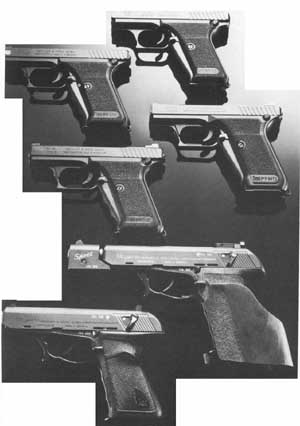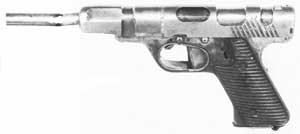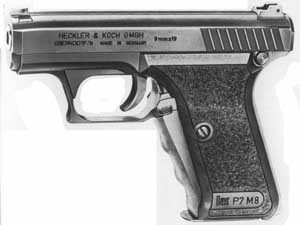Nation of Origin: Federal Republic of Germany
Model Ammunition: Operation: Weight loaded: Length: Length of barrel: Magazine capacity: Muzzle velocity: |
M8 9 x 19 mm delayed blowback 0.95 kg 171 mm 105 mm 8 rounds 351 m/s |
M13 9 x 19 mm
1.135 kg 169 mm 105 mm 13 rounds 351 m/s |
When Heckler & Koch developed the P9S (see previous entry), they were thinking in terms of a military pistol. When they developed the P7 series of pistols, they were thinking in terms of police pistols. Although armed and police forces both carry pistols, they can expect to use them in action in different ways and in differing circumstances. Military pistols have to undergo the rough and tumble of field operations, while most police pistols spend long periods of time carried in snug holsters and are rarely drawn in anger. When police pistols are drawn with in tent, they have to work faultlessly but safely, or there will be all manner of problems, to say nothing of dead policemen.
Thus when Heckler & Koch produced the P7 they decided to make changes from the normal run of pistols. For a start they did away with the usual array of locking systems. Once again, the almost universal 9 x 19 mm Parabellum cartridge was chosen for the new pistol by the continuing demand. To deal with the recoil forces involved, the selected locking system turned Out to be an unusual gas-operated delayed blowback system.
The P7 locking system was employed widely for the first time with the German ‘last ditch’ series of Second World War ‘Volkspistole’ of 1944 and 1945. As the round in the chamber is fired, some of the propellant gases are directed through a port close to the chamber into an enclosed chamber. The front part of the chamber is the face of a piston connected to the slide. As the recoil forces attempt to drive the slide and its integral breech block to the rear, the gases in the chamber are still expanding and exert pressure to keep the piston in place. By the time the recoil forces overcome the internal chamber gas pressure, the bullet has departed from the muzzle and chamber pressures have fallen to a safe level, and the slide and breech block can then move to the rear. This gas-delayed blowback system is positive, simple and reliable, and has the advantage that some of the recoil forces produced on firing are absorbed by the gas pressure. There are also fewer parts to wear out or break.

The range of Heckler & Koch
pistols, from the top: 765mm P7 K3; P7 P7’S firing plastic training
ammunition (note the spot near the muzzle); 9 mm P7 M13; 9 mm P7 M8;
9 mm P95 Sport sporting target pistol; standard 9 mm P9

The World War 2 ‘Volkspistole’,
an unusual weapon designed for mass production during the latter stages
of the war, and one of the first to employ the gas operated delayed
blowback operating system now used on the Heckler & Koch P7.
The P7 locking system is unusual in itself, but it is allied to a rarely-employed cocking system. To fire the weapon, the chamber is loaded by pulling the slide to the rear in the usual way and allowing it to slide forward again. A round is chambered and as the firer grips the butt, his hand grip automatically depresses a contoured lever on the front of the grip to actuate the cocking mechanism. The pistol will remain cocked for as long as the firer’s grip is maintained, and will fire when the trigger is pulled in the normal way. If the grip is released, the pistol will return to an uncocked state.
The grip device acts as the pistol’s safety mechanism for the simple reason that no other device is required. The pistol is suitable for use without modification by right’ and left-handed users, and again the system is simple and reliable. Overall reliability is further improved by the way the box magazine is angled, For good and consistent feed, automatic pistol box magazines should offer their cartridges to the breech block from a near vertical position. If this was carried to its logical conclusion, automatic pistol grips would be vertical as well, but that would make them awkward to grasp. Most modern pistols have angled grips for user comfort, ease of aiming and a firm grip, so most magazines have to be angled as well. On the P7 the butt is angled but wide, wide enough for the magazine to be almost vertical inside the butt, to improve the feed angle to an optimum for feed reliability.
Police forces have learned the hard way that most policemen are poor shots unless constant training is provided, so on the P7 aiming is made as easy as possible. The usual fore and rear sights are provided but the fore sight bears a prominent white dot and the rear sight has two more white dots, one each side of the rear sight notch. By placing all three dots side-by-side and in line with the target, aiming is made as rapid and easy as can be devised without recourse to far more complex methods. Aiming is assisted by the good balance of the weapon and the large and comfortable butt grip.
There are two main versions of the 9 mm P7. The P7 M8 has an 8-round magazine, while the P7 M13 holds 13 rounds. The P7 series does not end there. There is the smaller and lighter P7 K3 which does away with the gas delay system altogether and employs simple blowback instead, as it fires less powerful cartridges such as the 9 x 17 mm Short, 7.65 x 17 mm Browning or 0.22 rounds. The P7 K3 is intended for use as a staff officer or plain clothes police pistol, and retains the grip cocking device.
Then there is the P7 PT8. This is not intended to be a combat pistol, but a training pistol that can fire a special training round produced by Dynamit Nobel; the pistol is otherwise identical to a conventional P7. The training round was designed to enable useful pistol training to be carried out safely and relatively cheaply on short indoor or outdoor ranges, and the maximum range is only 125 meters. The cartridge fires a soft plastic bullet, is identical visually and dimensionally to the conventional 9 mm Parabellum round and is accurate at short ranges. It has been suggested that the training cartridge combined with the P7 PT8 could have an operational role in locations such as in pressurized aircraft to Counter hijacking or other criminal actions. Other similar operational scenarios could be possible.

The Heckler & Koch P7 M8 pistol note
the cocking lever in the front of the butt.
A recent variant of the basic P7 about which little has yet been released is the P7 M45. This has been designed for the American market, chambered for the .45 ACP cartridge, and differs from the standard P7 in using oil instead of gas to produce the delayed blowback locking system. On the P7 M45 the internal piston operates in a cylinder filled with oil. As the recoil forces tend to push back the internal piston after firing, they attempt to com press the oil. As the oil is compressed, it is gradually circulated through a closed-loop system by a release valve in such a manner that the travel of the piston is hindered to the point where the recoil action is made smooth and far less violent than is possible using a conventional action. The entire recoil process is rather like that used in an artillery recoil system. At the time of writing, the P7 M45 had yet to be released on to the market, for the recoil system was still in its final stages of development.
It should be remembered that the P7 series pistols were intend ed as police pistols. While they have had considerable success in that sphere, including breaking through into the difficult American police force market, just as much success has been achieved in the military market. Special forces units all around the world have taken to the P7 with considerable gusto, and many now use it as their main side arm, while more conventional armed forces have also ordered the type. One example that can be quoted is Greece where the local government arms production organization (Hellenic Arms Industry SA) have taken out a license production agreement to produce the P7 for the Greek armed forces and local exports -- they call ‘their’ examples the EP7.
Prev: Heckler & Koch P9S
Next: Uzi Pistol